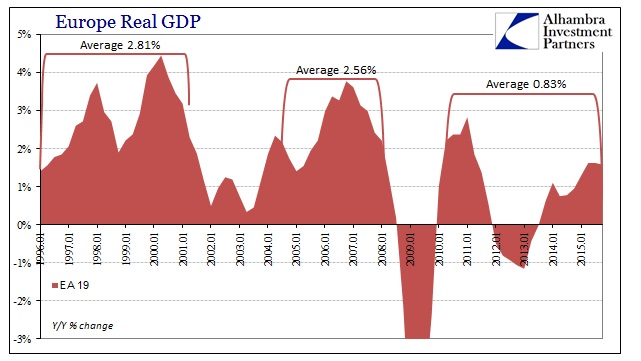Because industrial production for the Eurozone was estimated to have risen 2.4% in January, first quarter GDP was boosted to 0.6% (quarterly rate) as statisticians were expecting that European industry would at least hold up the rest of the quarter. While not figuring the same blistering pace, the GDP figure suggested at least the European economy holding on to that gain. The latest update for IP through March, however, shows that was wishful thinking. In March, industrial production was believed to have dropped 0.8% after falling 1.2% in February. Instead of what was called robust GDP it leaves barely any of the January jump with which to keep it that way.
The implications are that the next revision in European GDP will be sharply downward, undercutting a great deal of the regular ritual extrapolating any positive into “the” positive. A full part of that problem is believing that 0.6% is anything close to the necessary level of recovery to begin with. Even if the coming revision shows 0.0% growth, it truly isn’t any different than the first estimate of 0.6%. If it’s not something like 2% (meaning 8.5% to 9% or better at an annual rate) then it isn’t anything like actual growth.
That is what this “recovery” has become and it is a global reduction. Economists and the media have taken to splitting hairs over decimal point differences as if that were the division between actual success and failure; it is all failure. Not only that, nobody seems to appreciate how the global economy, not just Europe, not just the US, suddenly “forgot” how to grow all at the same time. It’s the biggest story this century; instead the media sells 0.6% as if it were monetary genius and proof of “stimulus” when it is only yet another quarter’s confirmation that the global economy is further synchronized in decay.

As you can see above, GDP is advancing again and has been since the middle of 2013 but that is far from the same as recovery. These positive numbers don’t even come close to matching the already downshifted growth in the middle of the last decade. In nominal terms, the comparison is even worse particularly when accounting for repeated and sustained “stimulus.”










Leave A Comment